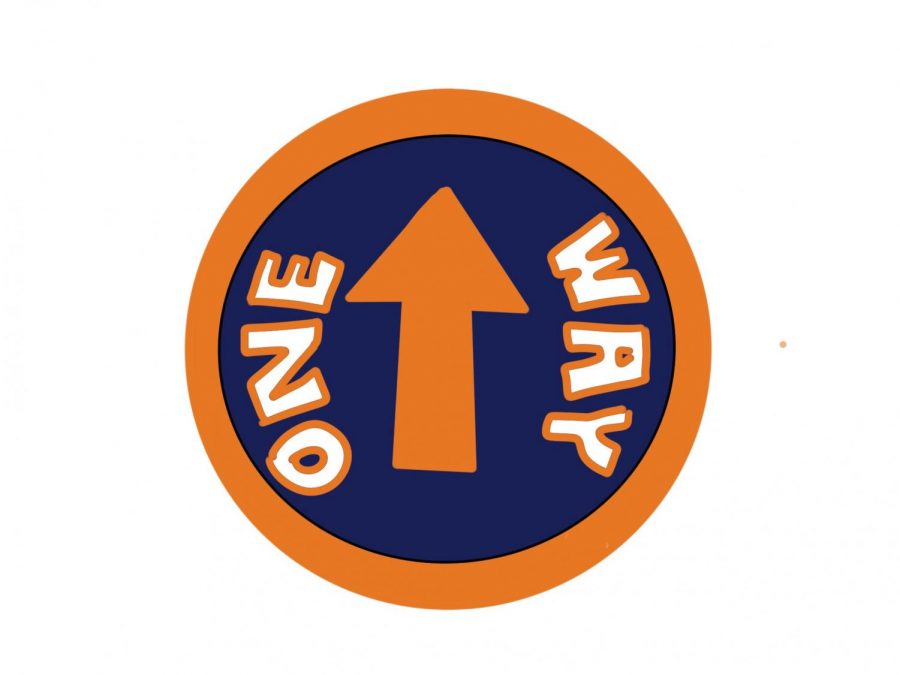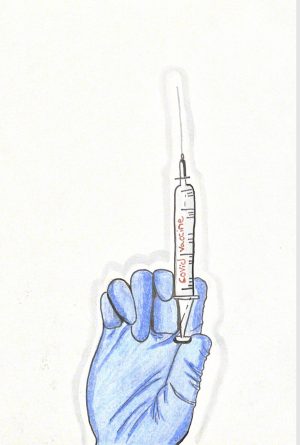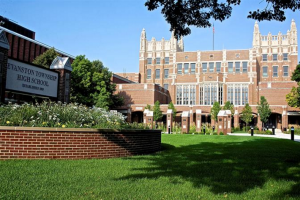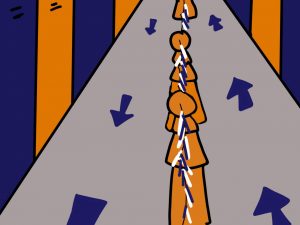A brief timeline of ETHS’s reopening journey
March 22, 2021
Since the March 12, 2020 announcement that students wouldn’t return to ETHS classrooms for three weeks—a time span which quickly lengthened—an air of uncertainty has surrounded the school’s education plan. ETHS’s approach to e-learning and reopening has been forced to evolve along with the virus, with the most recent development being the March 1, 2021 announcement that the school would be transitioning to a hybrid model on April 14.
From the beginning, ETHS has insisted that its main focus has been maintaining the wellbeing and academic achievement of its students and that this has been the guiding principle throughout the planning for both e-learning and a return to in-person school.
“We’ve had over 100 people—that includes students, that includes teachers, support staff, surveys and leaders across the district—working on [this plan],” said Superintendent Eric Witherspoon in a July 13, 2020 board meeting. “It’s going to have to be a living document, because we know conditions are changing rapidly with this virus.”
Witherspoon also described what the hybrid learning plan would look like in the July 13 meeting, and it sounds remarkably similar to the one that will be implemented on April 14: students would be organized into four groups (A, B, C, D) with 25 percent of the students in the building at a time. The rest of the students, and anyone who opts not to participate, would continue to attend class on Zoom in the enhanced e-learning format that students are now so familiar with.
Aside from the fact that the original plan would have allowed students to eat lunch at school, the most notable difference is that that hybrid plan was supposed to be implemented right after Labor Day.
“We’ve had training all summer long, but… we need to get our staff in here to get it all up and running, we need to make sure that it’s clear how to do this with masks and distance learning… to make sure they understand how it’s going to function in this school while they are teaching,” Witherspoon said regarding the transition timeline in July 2020.
Shortly after this plan was announced, the decision was made to postpone reopening indefinitely. While this was disappointing to many, it wasn’t necessarily surprising. As August came, so did COVID-19 surges that made a full semester of e-learning look more and more likely.
“In just those few short intervening days between discussing the framework and issuing a plan, a lot happened: a major outbreak of 36 students at three sports camps up in Lake Zurich, who all tested positive and actually resulted in some additional surge in that community,” said Witherspoon at the Aug. 10 board meeting.
“We’ve lost a lot of Evanstonians. We’ve lost a lot of elderly Evanstonians. We lost Hecky Powell,” Witherspoon continued. “I’m sorry. We didn’t create this pandemic, but we’re doing everything in our power to not be putting people at risk.”
With this, ETHS shifted focus to making e-learning as effective as possible.
“School will start on [Aug.] 17. At that time, I want students, as well as parents, to please understand this is a real school year,” said Witherspoon in an Aug. 7 E-Town Live. “[Students] must be keeping up with [their] assignments, attendance every day and every class period will count, we are going to have real grading, we are going to have assignments and deadlines.”
Aside from emphasizing the education aspect of e-learning, Principal Marcus Campbell made sure to point out that ETHS was continuing to focus on students’ wellbeing.
“During this time, wellbeing is interwoven in everything that we do…. So our teachers are actually interweaving wellbeing aspects into their lesson, you can look for that,” said Campbell. “Our teachers have also been trained early this summer and to think about how they build community in the classroom.”
As the school year began, e-learning moved ahead as planned. The school focused on materials distribution for students, providing social workers for students and reassigning staff whose positions were not as essential during a period of e-learning.
“For example, we don’t need the same numbers of people in here supervising the hallways… but our students have many needs that are beyond even what we would normally have,” said Witherspoon on an Aug. 28 E-Town Live. “We now have repurposed dozens of people who are going to be following our students, identifying those who have the greatest needs and providing more and more support to them so that they can have the most successful school year possible.”
As the school year continued on remote learning, it became ever more clear that e-learning, while not substandard, was very different from being in person. However, ETHS decided to commit to the e-learning model for the rest of the semester, citing the unsuccessful attempts by neighboring highschools to return for hybrid learning.
“There are some other districts in Illinois who started hybrid one week ago today, and they are not open a week later. Some started their hybrid plans less than a week ago today, and they are not open today,” Campbell said during the Oct. 13 board meeting. “We know that the hybrid model is more instructionally disruptive. There are definitely significant challenges to remote learning, but it is the best option for the continuity of instruction, and my peers are bearing this out.”
Campbell also emphasized that hybrid learning would not look like a normal school; not only would teachers be in masks teaching 75 percent of the class remotely, but ETHS wouldn’t be the social place it usually is.
“[Students] are not going to be together in classrooms, we will not allow them to congregate in the hallways and they can’t… be together in the cafeterias,” said Campbell.
The question of when students would be able to return to some form of in-person learning persisted. In an Oct. 16 E-Town live, Witherspoon cited the facts, saying, “The Harvard Global Health Institute has recommended that there be no more than a 3 percent positivity rate for it to be safe to reconvene in a setting like a school… We are currently at a seven-day rolling average of 5.9 percent positivity rate.”
According to the IDPH website, there was a seven-day rolling average of 3.4 percent positivity rate in Region 10 (which includes Evanston) on March 1, the day the hybrid plan was announced.
In November, Governor J.B. Pritzker announced that low- and medium-risk winter sports would be allowed to happen in person, with strict safety guidelines from the IDPH.
“It will be a good chance for us to start to see how well we can handle very small groups, in very controlled settings and in limited amounts of time with indoor activities,” said Witherspoon in a Nov. 6 E-Town Live.
As winter break finally came in sight, many students and staff alike wondered whether the new semester would bring with it a possibility of a return to some form of in-person learning. But, as the holidays came and went, it was made clear that ETHS would not be returning to in-person learning at any point in the near future.
In a Dec. 14 board meeting, Witherspoon made a point of highlighting the eye-popping national statistics regarding COVID-19 as justification to remain in remote learning.
“It is just tragic to talk about how over 3,000 Americans are dying every day now, over 300,000 Americans have died and it’s predicted that over 400,000 Americans will have died by the time President Biden is inaugurated. It’s truly a national and a human tragedy, but there is just simply no projecting right now that it would be safe at the beginning of the second semester for us to be the only high school in the entire area trying to open up at that point.”
Witherspoon and the rest of the ETHS administration maintained this stance as the calendar flipped from 2020 to 2021. In a Jan. 8 board meeting, Witherspoon repeated his stance from December, however, he incorporated a sense of optimism that some sort of hybrid learning model could be attained in the coming months.
“December was the worst month yet in terms of deaths in the pandemic. We know that the prediction that there will be a post-holiday surge in the month of January,” said Witherspoon. “But, we have made a commitment that we will do everything we can to go to the hybrid model sometime this semester.”
As the cold weeks of January continued, the support for some sort of in-person instruction seemed to be rising amongst the administration. By February, ETHS created a program where students could come into the building for select in-person experiences.
“The metrics in Evanston are really quite favorable right now,” said Witherspoon at the time. “Because of these metrics that we have right now, we are really feeling confident that we can offer in-person experiences for our ETHS students and start getting them back into the school.”
Campbell added that “in-person experiences at ETHS will help develop well-being and belonging for students.”
It wasn’t until March that the pursuit of hybrid learning by the end of the year went into full effect. This was the result of a variety of factors, most notably the rapidly declining cases of COVID infections and deaths in Illinois, Cook County and the City of Evanston.
ETHS parents and guardians were asked to fill out a form on their student’s behalf that would indicate whether or not they would return to school for in-person learning. This was due by the end of the first week of March.
However, the plan is not to begin the hybrid learning plan until the first week of April, after spring break. For seniors, who graduate in early May, there will only be three or four times in which they’d actually get to be inside the building for each of their classes.
“I think some seniors are having senioritis and not that interested, but I think some seniors would [come back], even if it’s only a handful of times,” said Witherspoon. “I think some of the seniors will just like the idea, ‘I did get back into my school a little bit before I graduated.’”
It remains to be seen how many students will show up for in-person learning once it starts in early April. But regardless of this, Witherspoon and the rest of the ETHS administration are proud of what the school has been able to accomplish academically this year. “One of the things that has not really surprised me, but pleased me is how adaptable we can be as human beings,” Witherspoon said.














